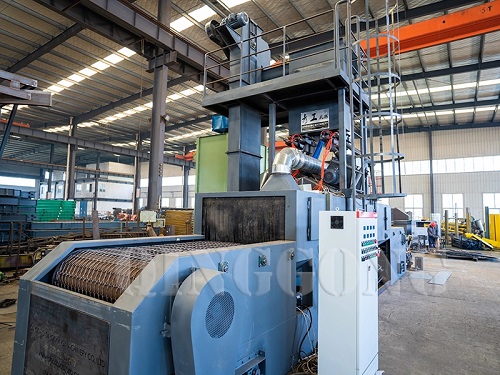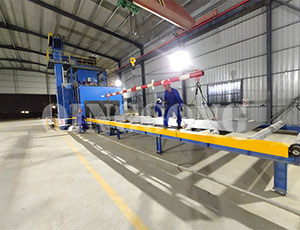The sand blasting room is more common for the rust removal of medium or thick plates, and pickling is no longer used. The sand blasting has high productivity and low cost, which can improve the surrounding sanitary conditions and reduce labor intensity. After its spraying, the surface of the board shows uniform roughness, which can increase the surface area, and increase the adhesion of the paint, and prolong the service life of the paint, enhance the protective effect of the coating film.
The type of sand blasting equipment
Sand blasting equipment is divided into horizontal and vertical. The horizontal type is the steel plate laying horizontally, and the vertical type is the steel plate laying upright. Usually, both sides will be sandblasted at the same time. The horizontal sand blasting room is more convenient for the steel plates to convey, and its production capacity is large, the adoption is more popularized, but it takes up a lot of space and the equipment is too heavy. The vertical type requires a vertical plate turning machine, which is not suitable for steel plates which are thin and wide. It is easy to fall when standing, but it occupies small area, and the pill does not need to be removed if it fell. The equipment is light, but the processing capacity is low and the sand blasting room is too narrow to maintain. Therefore, nowadays, it has been rarely used.
The horizontal sand blasting room is equipped with 2-8 impeller-type throwing heads above and below the steel plate. Each of the throwing heads is driven by an electric motor and it is high-speed impeller rotation. By the centrifugal force, the steel shot or iron shot will be thrown on the rust-removing steel plate at a speed of about 80m / s, removing the oxide scale and rust on the surface based on the impact of the shot and the friction with the steel plates.
The structure of the sand blasting room
The sandblasting room is generally composed of conveying roller table, sand blasting machine, sand blasting chamber, sand blasting recycling system, sand removing device and dust collecting device. The roller table rollers under the throwing head need to consider the requirements of wear resistance; the entrance and exit of the sand blasting chamber should be sealed with curtains to prevent dust and dust from affecting the working environment; the surface of the board should be blown away with iron brushes after the throwing; the shot should be collected into dispenser for reuse after filtered, and the dust should be collected by the dust collector. The sand blast which has been consumed should be replenished regularly.
The application of the sand blasting room
The blasting removal rate should reach 100%. If it is not reached, it should be returned to the cleaning for the second time or it can be partially removed manually.
After spraying, the roughness of the board should be measured by the penetration depth, which should generally be less than 50 μm. The cleanliness and roughness depend on the blasting speed. The higher the speed is, the larger the impact function, is and the better the cleaning effect is, and the larger the roughness is. After that, the cleanliness and roughness also depend on the sand particles. The finer the particles are, the more the number of shots thrown per unit time is, the more the number of the impacts, the higher the density is, the clearer it can clean. However, the larger the particles are, and the greater the roughness is, the larger the number blasting sand, and the larger the flow rate is, and the degree of clearing will also be good. In addition, the longer the duration of the ejection is, the higher the degree of clearing is, but it has little effect on the roughness.
 EN
EN
 fr
fr  de
de  es
es  it
it  ru
ru  pt
pt  ar
ar  th
th  pl
pl  ro
ro 


